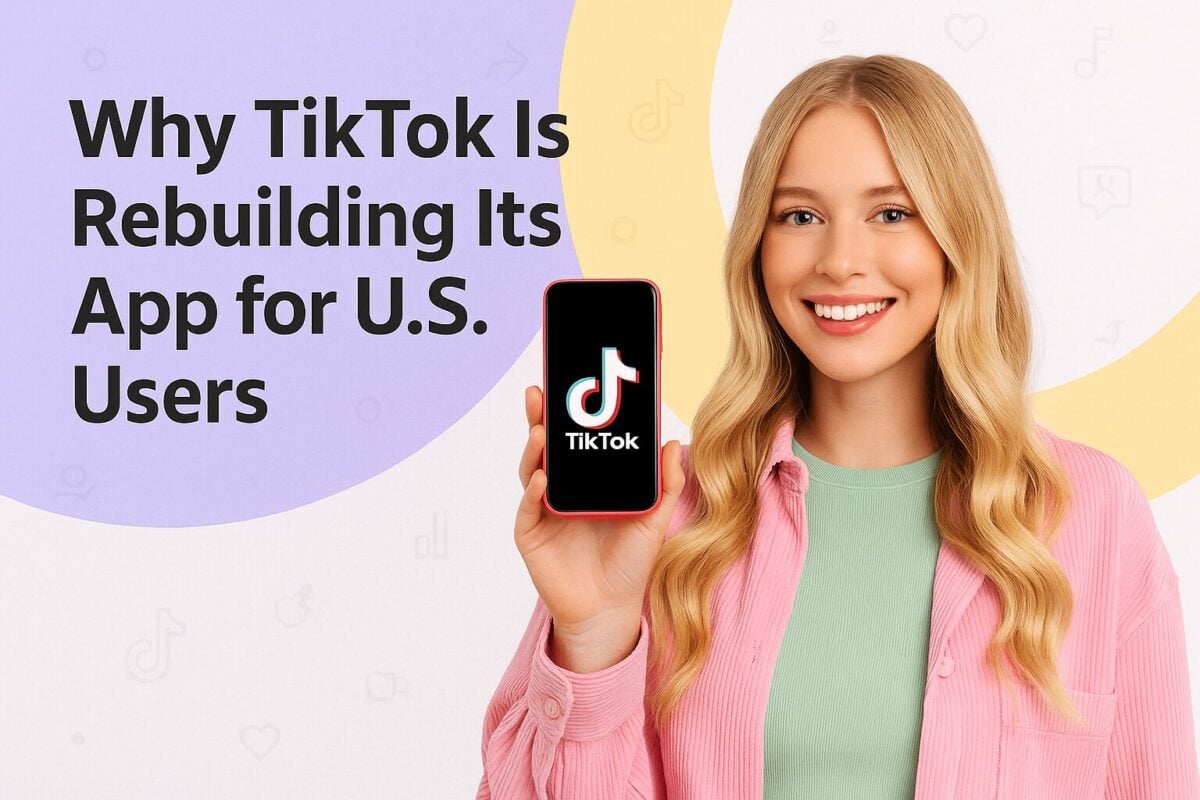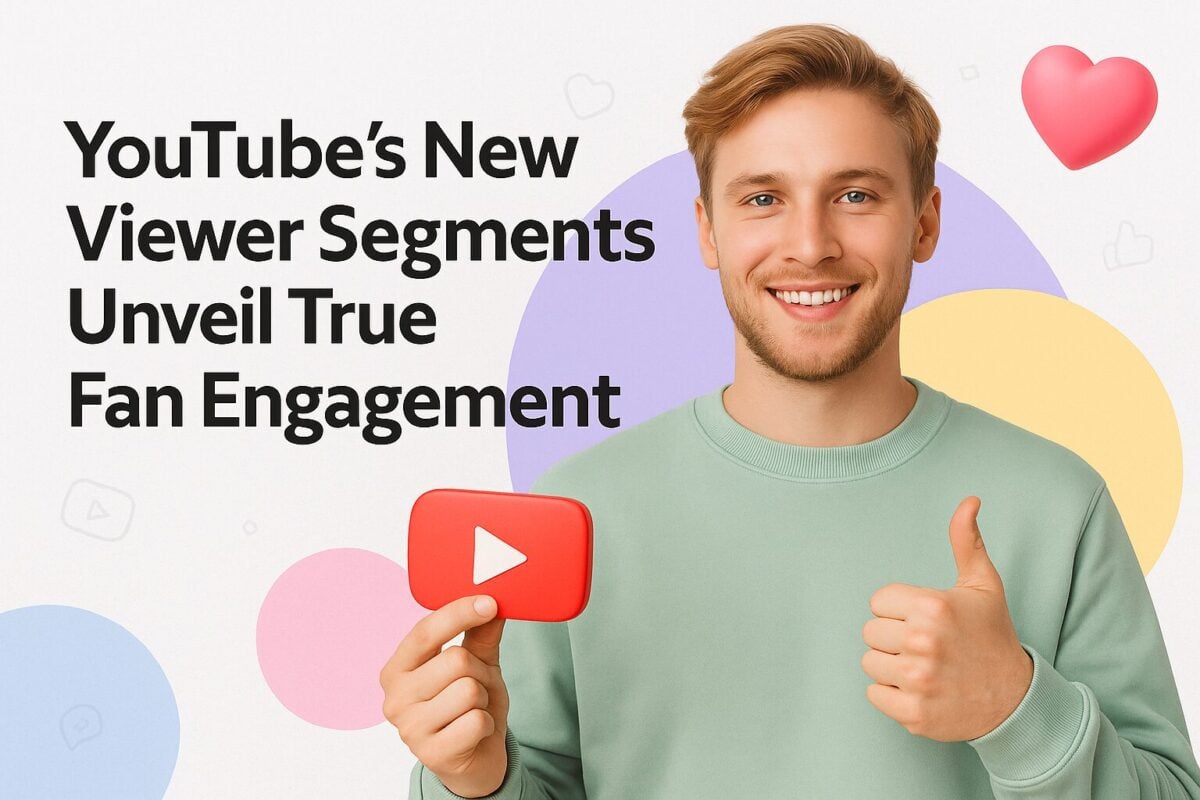If you're an influencer or content creator, you might not think you need to worry about business plans and executive summaries. But having at least an executive summary can go a long way toward showing your professionalism and how seriously you take the work that you do. We've pulled together a few executive summary examples that you can adapt and use for your own business.
Executive summaries can help you convince investors, venture capitalists, and the brands you approach for partnerships and sponsorship agreements that you're worth the investment. And some of the best executive summaries are just a single page long! Even if you've never heard of an executive summary before, you can put one together in less than an afternoon and it will give you more clarity around your business, where you want to go, and what you need to do to get there.
So, what exactly is an executive summary? And do you really need one?
What Is an Executive Summary?
An executive summary is an overview of a certain document, often a summary of a full business plan. The length of your executive summary and what you should include will change depending on how you're using it, your industry, and the type of work you do. They're typically no more than 1–2 pages long and will give the reader all the most important information they need to make a decision about whether or not they want to partner with you.
Executive summaries aren't written in stone. Instead, they're living documents, which means that you can — and should — change them as your business grows and changes. For influencers and creators, this might mean keeping your social media metrics up-to-date and updating your competitors, niches you work with, and the services you offer.
Time is a limited and valuable resource. If you want the right people to use their precious time to learn more about you, you need to make it easy for them. Your executive summary should be comprehensive enough to cover all the pertinent information the reader will need to make a decision about you while staying within 1–2 pages (preferably just a single page).
3 Executive Summary Examples
Here are three executive summary examples and executive summary templates you can use to create your own.
Executive Summary Example #1
This executive summary is built around the launch of a new product — a new watch series. The summary starts off with two interesting statistics that are designed to keep the reader engaged and reading. In fact, this summary includes several statistics, showing that they've done their research into the need for a new watch series.
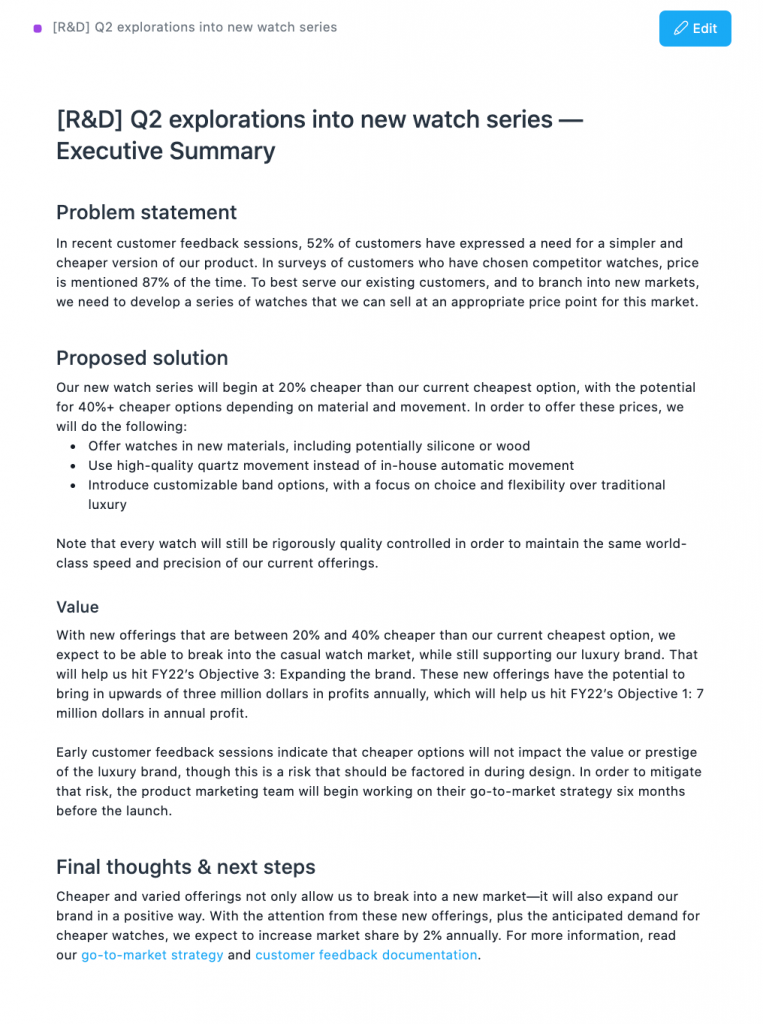
Source: asana.com
Executive Summary Example #2
In this example, the company is seeking funding. As you can see, the purpose of the executive summary has changed the elements that are included and the order in which they're listed on the page.
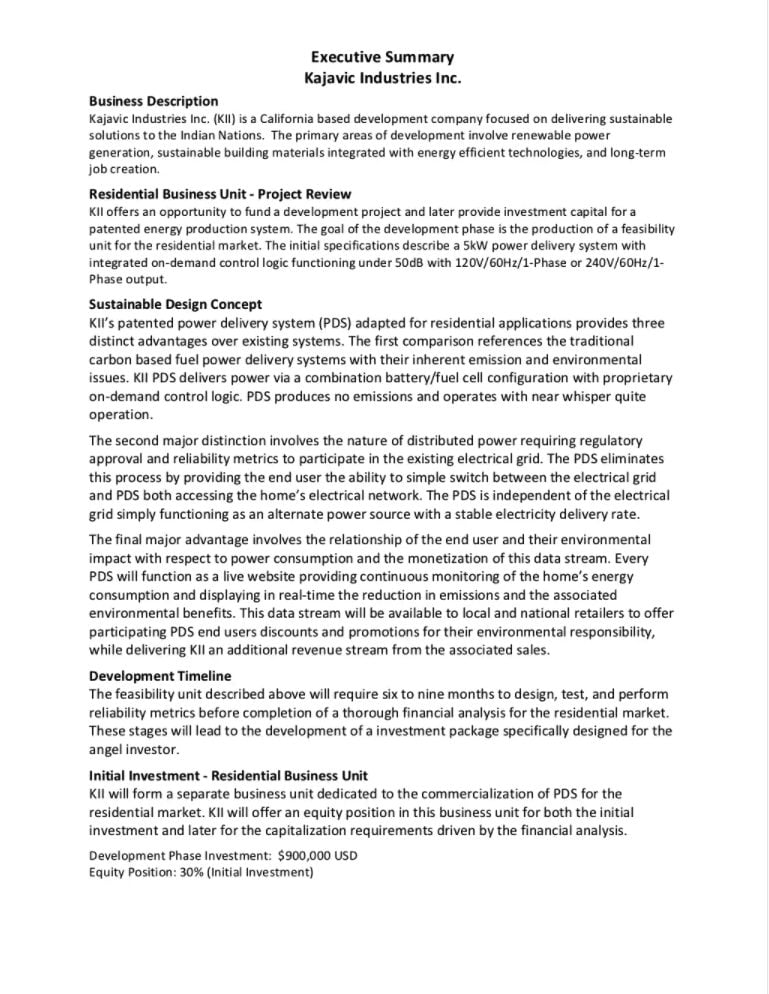
Source: slideshare.net
Executive Summary Example #3
This executive summary example is a bit longer than the others we've included. This might be overkill for most influencers and content creators, but we've included it here because if you're already running a successful membership site or subscription-based business, you might be looking for funding or a business loan to expand your business.
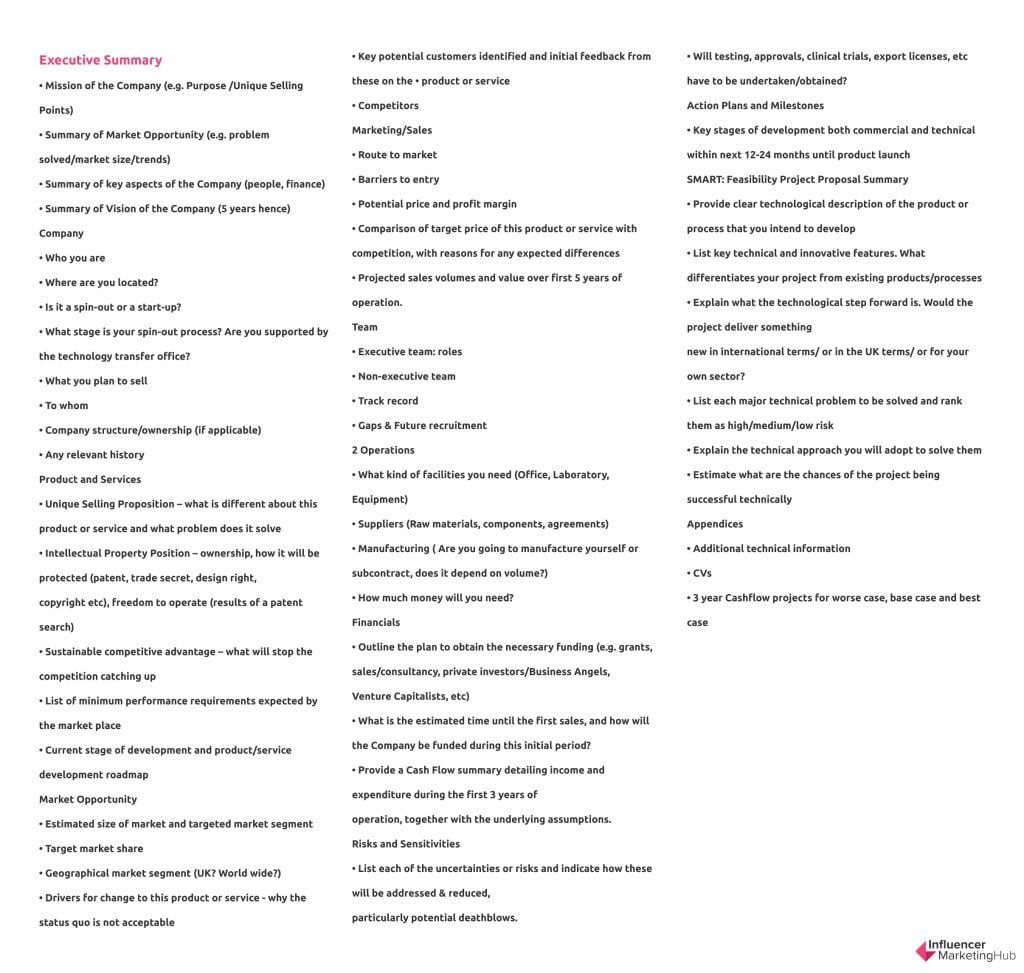
How Long Should an Executive Summary Be?
Your executive summary should be as short and concise as possible. Remember, you're dealing with busy people with limited time to devote to learning about your brand and services. We recommend keeping your executive summary under two pages.
Parts of an Executive Summary
While there are no set guidelines for how your executive summary should be organized, there are certain details about your brand, products, and services that you'll want to be sure to cover. Here's the information we recommend including in your executive summary to ensure that you're including all the pertinent information your potential partners may need.
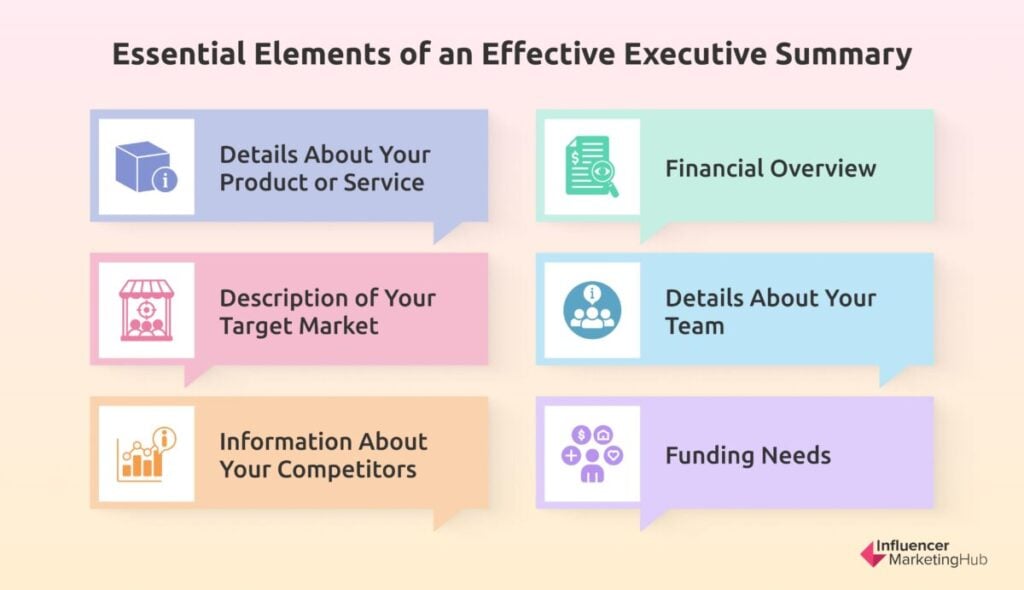
Details About Your Product or Service
Include details about your product or service along with the problem you solve. Don't worry, you don't need to offer a solution to poverty, you just need to solve a specific problem that your readers might need to solve. For influencers, this could mean sharing the benefits of partnering with you to promote a specific product (overlapping audiences, your engagement, previous influencer marketing campaign results, etc).
Description of Your Target Market
For influencers and content creators, the description of your target market varies slightly from what a brand seeking investors might include in this section. That's because your target market is probably the person who is reading your executive summary but their target audience is the one you should be considering. So, instead of describing your target market as brands in a certain industry seeking influencers, your target market for your executive summary will be whomever you can reach for the brand you're pitching.
Information About Your Competitors
Anybody who has a product or service to offer has competitors. Briefly share what it is that your competitors offer and how you differ from them. This is a great opportunity to really highlight what sets you apart from other influencers or creators.
Financial Overview
Most executive summaries will include a section about the company's finances. For influencers and creators, your readers probably aren't going to care how much money you've earned. Instead, they're going to want to know how much you've been able to bring in for the brands you represent. Here you'll want to highlight any monetary results as well as details about any improvements you've driven for traffic, engagement, referrals, and any other social media metric or other benchmark showing that you get results.
Details About Your Team
If you have a team or regularly partner with other influencers or creators, this is where you'll mention those details. Brands want to know who they're dealing with, so if you outsource any of your content creation, videography, photography, or social media posting, you'll want to share that information here.
Funding Needs
A lot of the time, businesses use their executive summary as a way to win over investors to fund them. For influencers and creators, this section will focus on what type of relationship you're looking for. If you have specific rates, share them here. If you offer packages or trade services for products, mention that too. This section is where you let the reader know how you expect to be compensated for the work you do for them.
Executive Summary Best Practices & Tips
Writing an executive summary can seem overwhelming if you have no experience with business writing or have never created a business plan. Here are some executive summary best practices and tips to help you work through creating a stellar executive summary that will have brands lining up to work with you.
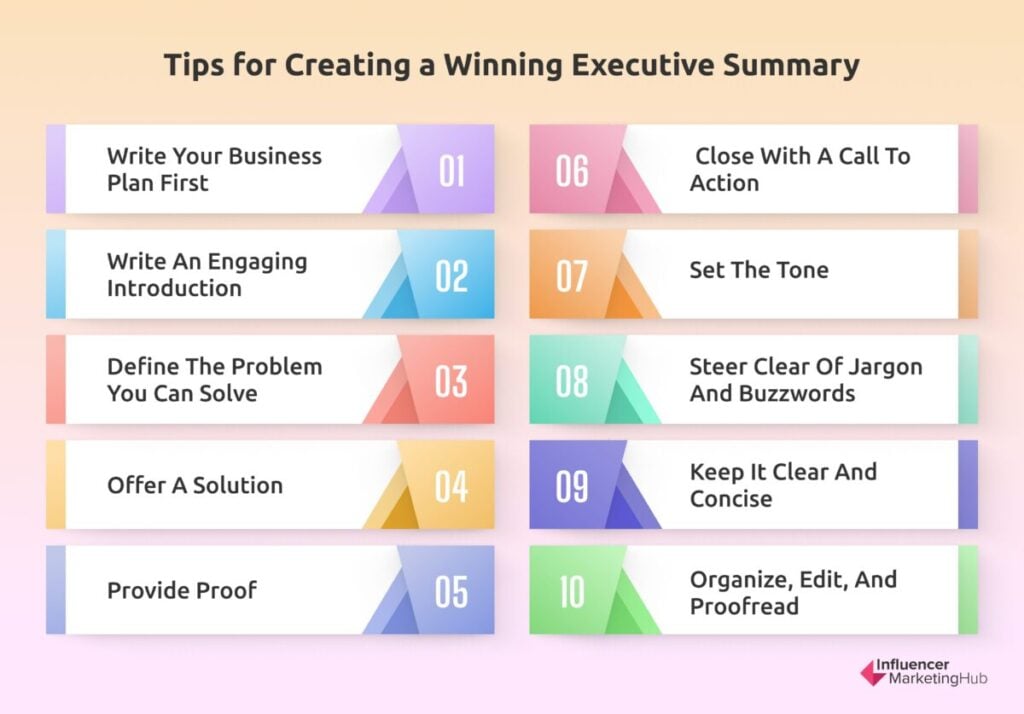
1. Write Your Business Plan First
An executive summary is just that — a summary. It's the most important piece of your overall business plan. You may think that you don't need a business plan as an influencer or creator, but having one makes you look incredibly polished and professional. That's why we recommend writing your business plan and then using that plan to craft your executive summary.
2. Write an Engaging Introduction
Just like any content, your executive summary needs to grab the reader's attention and keep them engaged. The introduction to your executive summary should include a hook, something like an interesting statistic about your industry or niche, or maybe a compelling story. The introduction should be relevant to your products or services and industry as well as give readers insight into what they can expect from the rest of the summary.
3. Define the Problem You Can Solve
Clearly define the problem that you can solve for the brands you're pitching. What is the business need behind your product or services? What are they missing out on by not partnering with you? This is where you let your readers know that you understand their pain and can provide a solution.
4. Offer a Solution
Now that you've shown your reader that you understand their pain and illustrated how their business is limited without you, it's time to offer a solution. This is the "dream state," what their business can achieve with your help.
5. Provide Proof
It's time to sell yourself. Let your readers know that you know what you're doing. In this section, you'll include social proof as well as hard results and statistics showing how your previous partners have benefited from your work.
6. Close With a Call to Action
You should always let people know what their next steps should be. If you don't, they're not going to do anything at all. At the end of your executive summary, tell the reader what to do next. This can be really simple: "If you're ready to drive traffic and increase sales with influencer marketing, let's talk!" along with your contact information.
7. Set the Tone
The tone you used when writing your executive summary will vary depending on your audience. This requires some research into the brands you're pitching. If you're writing for corporate brands that are more conservative and straightlaced, you'll want to use more professional language. For brands that are more quirky and fun, your executive summary will be more lighthearted. This isn't a terms and conditions page, so be sure to use personal pronouns like "I," "we," and "our" instead of stuffy references to "the Company" and "the Client."
8. Steer Clear of Jargon and Buzzwords
Use language that is clear, concise, and free from jargon or buzzwords. While you'll be writing for a specific audience, it's important to write in a way that is easy to understand by anyone. Again, research comes into play here. If the brands you're approaching all use the same verbiage, you should absolutely use that language in your executive summary. This sends a signal to the brands that you understand their industry and market. Don't assume that they know the lingo you use as an influencer or creator, however.
9. Keep It Clear and Concise
As you can see in the executive summary examples we've compiled, your executive summary should be clear and concise while conveying all of the information your reader needs. Don't include more detail than necessary to convey your value and success, and steer clear from listing specific tasks and due dates.
In addition to being clear and concise, your executive summary should be able to exist unsupported. This means that your reader should be able to get all the information they need to make a decision. If they want additional information, they'll ask you for it.
10. Organize, Edit, and Proofread
Organize your executive summary in a logical manner (take a look at the executive summary examples above for guidance). You'll want to put the most important and salient elements at the beginning of the document. When you're done writing, be sure to edit and proofread your executive summary before sending it off to anyone. We recommend asking a peer or mentor to review it.
Executive Summary: An Important Piece to Any Business Plan
An executive summary is a great way to not only refine your own vision of where you want to go with your business but to share that information with brands you're seeking to partner with. It's a quick and easy way to share the information that matters and with the executive summary examples we've included here, you have everything you need to create your own executive summary that will win you deals.
Frequently Asked Questions
Why do I need an executive summary?
Executive summaries provide an easy-to-consume snapshot of your products and services that investors or potential partners can review quickly and make a decision. It might be the only information a prospective partner reads about you before they make a decision.
How long should my executive summary be?
Your executive summary should be as short and concise as possible while still conveying all the important information the reader needs to make a decision. There are no universally accepted guidelines, but we recommend keeping your executive summary limited to 1–2 pages.
What should I include in my executive summary?
Your executive summary will likely include:
- An introduction
- Details about your product or service
- A description of your target market
- Information about your competitors
- A financial overview
- Details about your team
- Your funding needs
How can I make my executive summary interesting?
Here are tips to keeping readers engaged in your executive summary:
- Write an engaging introduction
- Define the problem
- Offer a solution
- Provide proof
- Include a call-to-action

